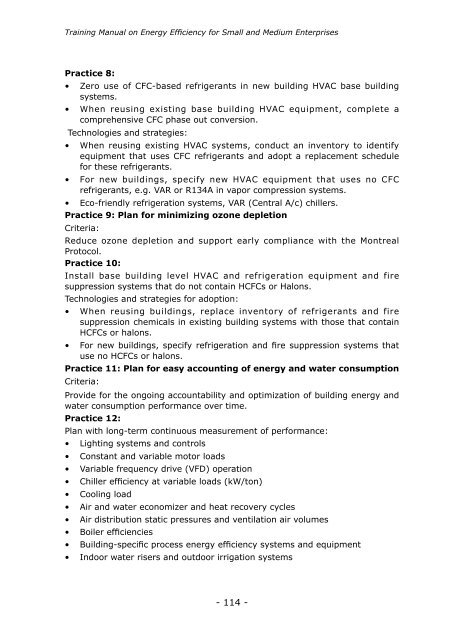Training Manual on Energy Efficiency - APO Asian Productivity ...
Training Manual on Energy Efficiency - APO Asian Productivity ...
Training Manual on Energy Efficiency - APO Asian Productivity ...
Create successful ePaper yourself
Turn your PDF publications into a flip-book with our unique Google optimized e-Paper software.
<str<strong>on</strong>g>Training</str<strong>on</strong>g> <str<strong>on</strong>g>Manual</str<strong>on</strong>g> <strong>on</strong> <strong>Energy</strong> <strong>Efficiency</strong> for Small and Medium Enterprises<br />
Practice 8:<br />
• Zero use of CFC-based refrigerants in new building HVAC base building<br />
systems.<br />
• When reusing existing base building HVAC equipment, complete a<br />
comprehensive CFC phase out c<strong>on</strong>versi<strong>on</strong>.<br />
Technologies and strategies:<br />
• When reusing existing HVAC systems, c<strong>on</strong>duct an inventory to identify<br />
equipment that uses CFC refrigerants and adopt a replacement schedule<br />
for these refrigerants.<br />
• For new buildings, specify new HVAC equipment that uses no CFC<br />
refrigerants, e.g. VAR or R134A in vapor compressi<strong>on</strong> systems.<br />
• Eco-friendly refrigerati<strong>on</strong> systems, VAR (Central A/c) chillers.<br />
Practice 9: Plan for minimizing oz<strong>on</strong>e depleti<strong>on</strong><br />
Criteria:<br />
Reduce oz<strong>on</strong>e depleti<strong>on</strong> and support early compliance with the M<strong>on</strong>treal<br />
Protocol.<br />
Practice 10:<br />
Install base building level HVAC and refrigerati<strong>on</strong> equipment and fire<br />
suppressi<strong>on</strong> systems that do not c<strong>on</strong>tain HCFCs or Hal<strong>on</strong>s.<br />
Technologies and strategies for adopti<strong>on</strong>:<br />
• When reusing buildings, replace inventory of refrigerants and fire<br />
suppressi<strong>on</strong> chemicals in existing building systems with those that c<strong>on</strong>tain<br />
HCFCs or hal<strong>on</strong>s.<br />
• For new buildings, specify refrigerati<strong>on</strong> and fire suppressi<strong>on</strong> systems that<br />
use no HCFCs or hal<strong>on</strong>s.<br />
Practice 11: Plan for easy accounting of energy and water c<strong>on</strong>sumpti<strong>on</strong><br />
Criteria:<br />
Provide for the <strong>on</strong>going accountability and optimizati<strong>on</strong> of building energy and<br />
water c<strong>on</strong>sumpti<strong>on</strong> performance over time.<br />
Practice 12:<br />
Plan with l<strong>on</strong>g-term c<strong>on</strong>tinuous measurement of performance:<br />
• Lighting systems and c<strong>on</strong>trols<br />
• C<strong>on</strong>stant and variable motor loads<br />
• Variable frequency drive (VFD) operati<strong>on</strong><br />
• Chiller efficiency at variable loads (kW/t<strong>on</strong>)<br />
• Cooling load<br />
• Air and water ec<strong>on</strong>omizer and heat recovery cycles<br />
• Air distributi<strong>on</strong> static pressures and ventilati<strong>on</strong> air volumes<br />
• Boiler efficiencies<br />
• Building-specific process energy efficiency systems and equipment<br />
• Indoor water risers and outdoor irrigati<strong>on</strong> systems<br />
- 114 -
















